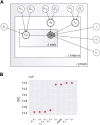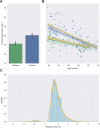The Processing-Speed Impairment in Psychosis Is More Than Just Accelerated Aging
- PMID: 28062652
- PMCID: PMC5472152
- DOI: 10.1093/schbul/sbw168
The Processing-Speed Impairment in Psychosis Is More Than Just Accelerated Aging
Abstract
Processing speed is impaired in patients with psychosis, and deteriorates as a function of normal aging. These observations, in combination with other lines of research, suggest that psychosis may be a syndrome of accelerated aging. But do patients with psychosis perform poorly on tasks of processing speed for the same reasons as older adults? Fifty-one patients with psychotic illnesses and 90 controls with similar mean IQ (aged 19-69 years, all African American) completed a computerized processing-speed task, reminiscent of the classic digit-symbol coding task. The data were analyzed using the drift-diffusion model (DDM), and Bayesian inference was used to determine whether psychosis and aging had similar or divergent effects on the DDM parameters. Psychosis and aging were both associated with poor performance, but had divergent effects on the DDM parameters. Patients had lower information-processing efficiency ("drift rate") and longer nondecision time than controls, and psychosis per se did not influence response caution. By contrast, the primary effect of aging was to increase response caution, and had inconsistent effects on drift rate and nondecision time across patients and controls. The results reveal that psychosis and aging influenced performance in different ways, suggesting that the processing-speed impairment in psychosis is more than just accelerated aging. This study also demonstrates the potential utility of computational models and Bayesian inference for finely mapping the contributions of cognitive functions on simple neurocognitive tests.
Keywords: Bayesian inference; aging; computational psychiatry; digit–symbol; processing speed; psychosis.
© The Author 2017. Published by Oxford University Press on behalf of the Maryland Psychiatric Research Center. All rights reserved. For permissions, please email: journals.permissions@oup.com.
Figures




References
-
- Elvevåg B, Goldberg TE. Cognitive impairment in schizophrenia is the core of the disorder. Crit Rev Neurobiol. 2000;14:1–21. - PubMed
-
- Reichenberg A, Harvey PD. Neuropsychological impairments in schizophrenia: integration of performance-based and brain imaging findings. Psychol Bull. 2007;133:833–858. - PubMed
-
- Saykin AJ, Shtasel DL, Gur RE, et al. Neuropsychological deficits in neuroleptic naive patients with first-episode schizophrenia. Arch Gen Psychiatry. 1994;51:124–131. - PubMed
-
- Glahn DC, Bearden CE, Barguil M, et al. The neurocognitive signature of psychotic bipolar disorder. Biol Psychiatry. 2007;62:910–916. - PubMed
Publication types
MeSH terms
Grants and funding
LinkOut - more resources
Full Text Sources
Other Literature Sources
Medical

